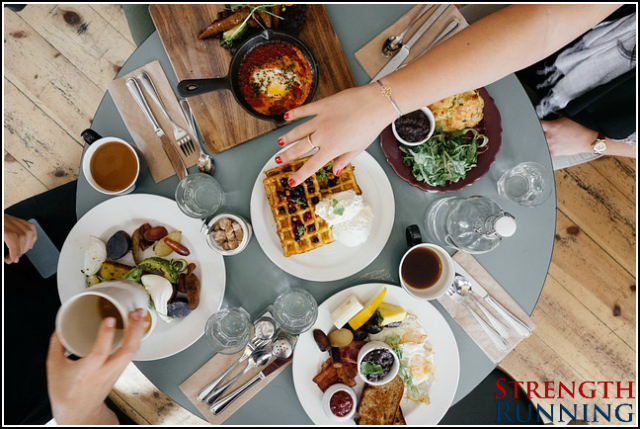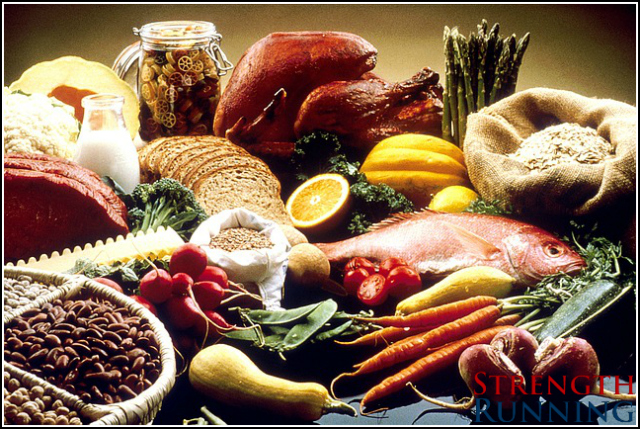You just ran a local 5k and you’re at brunch with friends, talking about how you’re training has went over the last few weeks.

Inevitably, somebody complains about their weight or not eating right. Let me know if any of these sound familiar:
- “Training went great, but I was starving after my long runs and binged on snacks. I have no self-control!”
- “I know! I’m always craving sugar when I run a lot and I make too many poor choices.”
- “I’m not sure about portion control – I’m hungry all the time and even gain weight during high mileage weeks!”
The struggle is real.
While I’ve never struggled with my weight (my body type is the same as an Olympic marathoner. A female marathoner…), I used to subscribe to this popular runner diet philosophy:
If the furnace is hot enough, anything will burn.
In other words, if I ran enough miles and hard workouts, I could eat anything. But while I wasn’t gaining weight, was I being healthy? Was I providing my body with the best fuel possible? Was my diet optimized for recovery and energy?
We can all agree that eating whatever you want is not healthy nor does it provide your hard-working body with the fuel and nutrients it needs to recover and run effectively.
You are what you eat, after all.
But for me personally, I’ve always struggled with the inconvenience of eating healthy, home-cooked nutritious meals. If I can’t “grab it and go” then it’s frustrating to spend my precious time on meal preparation.
Over the last 18 months, my diet has improved considerably (despite hating cooking and complex meals).
I owe this transformation to a few significant changes made possible by my work with Anne Mauney, MPH RD. She’s helped countless runners fuel smarter, lose weight, and eat intuitively.
And as I’ve improved my own nutrition, I’ve also been listening to many runners who struggle with many aspects of eating well:
- Meals that work for runners AND non-runners (probably not everyone in your family is a runner)
- Snacking is inevitable – but what are healthy, runner-friendly snack ideas?
- Fueling appropriately for long runs or interval workouts
- Figuring out meals that are both nutritious AND easy to prepare with no weird or hard to find ingredients
(by the way, we cover these questions in this Q&A series that I did with Anne)
These are some of the most helpful (and powerful) ways to eat healthier without spending all day in the kitchen. Because just you, I despise hours wasted preparing lavish meals every single day.
Front-Load Your Calories
This is a simple strategy but one that requires us to change our habits. Most of us do the opposite:
- Breakfast is small
- Lunch is medium-sized
- Dinner is large
- Don’t forget evening snacking!
The majority of our food intake happens later in the day. But as Nancy Clark, RD (Anne and I interviewed her for Nutrition for Runners) has said:
Front-loading calories helps tame the cookie monster!
The “cookie monster” is your insatiable desire to snack on unhealthy foods when you’re hungry. And it happens late morning and afternoon because you haven’t eaten enough during the first two meals of the day.
By front-loading your calories, you eat a larger breakfast and lunch (healthy, of course) so that you’re less likely to snack later in the day.
Moreover, it’s easier to eat healthy in the morning and early afternoon when your willpower is at your highest. We’ve learned that willpower is like a muscle and it gets fatigued throughout the day.
Curb your snacking and you’ll gradually enable yourself to eat slightly less while consuming more nutritious food.
That’s a win-win.
Simplify the Kitchen
A messy, disorganized kitchen is the fast track to take-out and bad decisions.
Instead, streamlining your kitchen and front-loading (there’s a pattern here!) the work will make meal prep, snacks, and healthier decisions much easier. No need to “try harder.”
There are three strategies that my family has used with great success to make healthy eating possible.
1. Batch cook and invest in lots of storage containers.
Cooking every single day is a drag unless it’s a passion that you love. For most of us, cooking 2-3 times as much as you normally eat is a way to work once but have several meals to show for it.
My wife and I adjusted to this approach after our first daughter began eating more than we did (seriously, that girl can EAT). Scraps of food from our own plates just didn’t cut it anymore.
We also use glass storage containers for all of the leftovers. We prefer glass for a few reasons:
- BPA-free
- Glass doesn’t stain, warp, or start to smell funky
- It’s safe for the oven, microwave, freezer, and dishwasher (lids are BPA-free and safe for the top-rack of the dishwasher)
For us, it’s a much simpler and more effective way to cook and store food.
2. Love the Crock-Pot.
Who doesn’t love a crock-pot (also known as a slow cooker) after using it a few times? They’re the ultimate “set it and forget” kitchen tool.
And even barbarians like me can cook delicious meals without spending all day in the kitchen!
Our model is easy to use, a cinch to clean, and can provide 2-3 full meals for a family of 3.5 (does our 10-month old count as a full person yet?).
And with our slow cooker cookbook, we never run out of ideas:
- Pulled chicken (for taco night)
- Stuffed peppers (rice, beans, cheese, salsa)
- Quarter-chicken (pro tip: save the broth for soup)
Used just once per week, a slow cooker like this one can save you more than an hour in the kitchen.
3. Get your greens the easy way.
Confession: vegetables aren’t my favorite food group. Maybe you feel the same way, but because I crave convenience, I often don’t eat any vegetables until dinner.
Until about a year ago when I got a Blendtec – “the last blender you’ll ever own.” This is the granddaddy of all blenders with:
- An industry-leading 8-year warranty
- Commercial-grade motor perfect for ice, frozen fruit, or raw vegetables
- The easiest jar I’ve ever cleaned and (I just learned this) a “safety blade” that’s not actually sharp (it spins at 300+ miles per hour so it doesn’t need to be sharp)
I use the blender for smoothies. Armed with tasty smoothie recipes from SGS I never run out of ideas.
My favorites: Pineapple Mojito and Peach Coconut Dream.
For a guy who just likes to grab a quick breakfast, a smoothie fits all my criteria and allows me to get in a great nutrition boost without cooking anything.
And fair warning: Blendtecs are not cheap. In fact, I almost had a heart attack when I first saw the price tag.
But every person I talked to said it was worth it. And after I pulled the trigger and got my own, I now know why: they’re truly the last blender you’ll ever own.
Eat for satiety

This strategy is far less common – but perhaps the most powerful. It forms a central pillar of our nutrition philosophy.
Put simply: eat nutrient-dense foods that fill you up, rather than nutrient-poor foods that leave you famished just an hour later.
We’ve all had the experience of eating a huge fast food meal, only to be hungry again soon after.
Why does that happen? A few reasons:
- Processed foods generally have far less fiber than “real” foods – so they’re digested faster.
- The have less “nutrition” (i.e., nutrients like vitamins, minerals, polyphenols, fiber, etc.)
- High sugar content from white bread, soda and fries spikes insulin, resulting in a crash that leaves you wanting to get your blood sugar level back up
- High sodium levels can make you feel thirsty, which is often mistaken for hunger
These empty calories don’t satisfy you the same way that a balanced meal with whole foods will.
A properly balanced meal includes every macronutrient:
- Healthy fats (from fish, nut butters, avocados, olive oil, greek yogurt, etc.)
- Complex carbohydrates (the less refined the better)
- Lean protein
When you include every macronutrient, rather than just one or two, you stay full for longer. Your digestive system has work to do and while your stomach is busy digesting, hunger cues are greatly reduced.
In our free nutrition course, we cover more examples – plus give you a free dietitian-approved shopping list, case studies, what not to do, and a lot more.
Want these lessons? Just sign up here and the first lesson will be on its way!